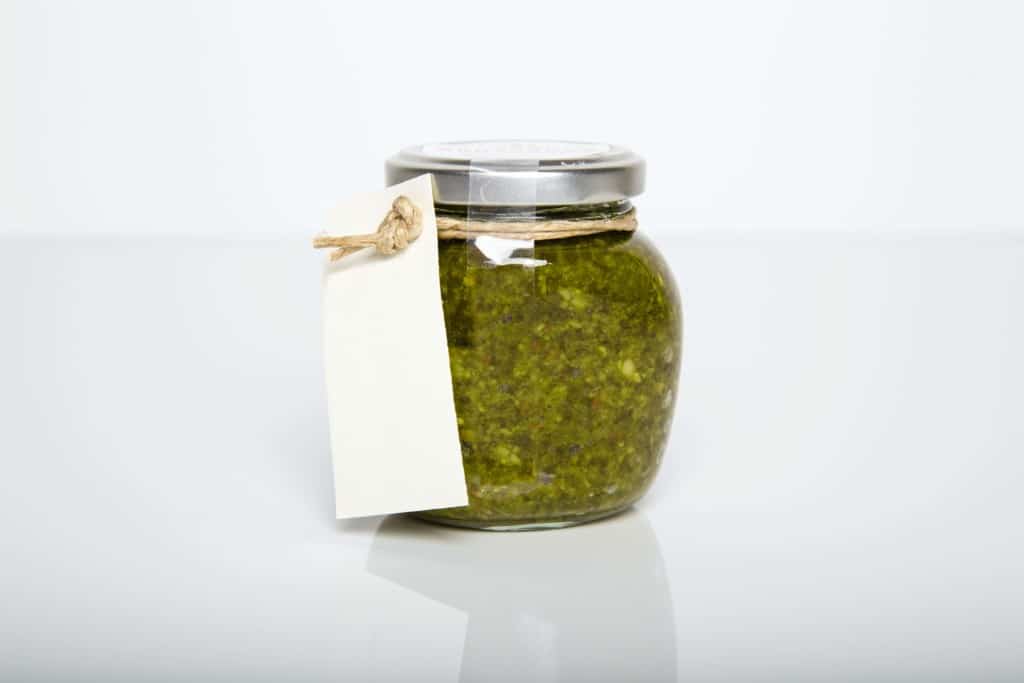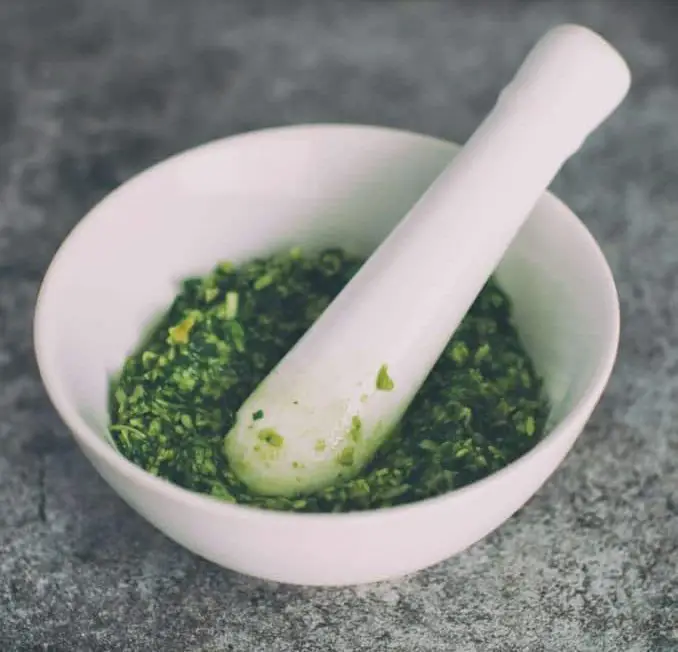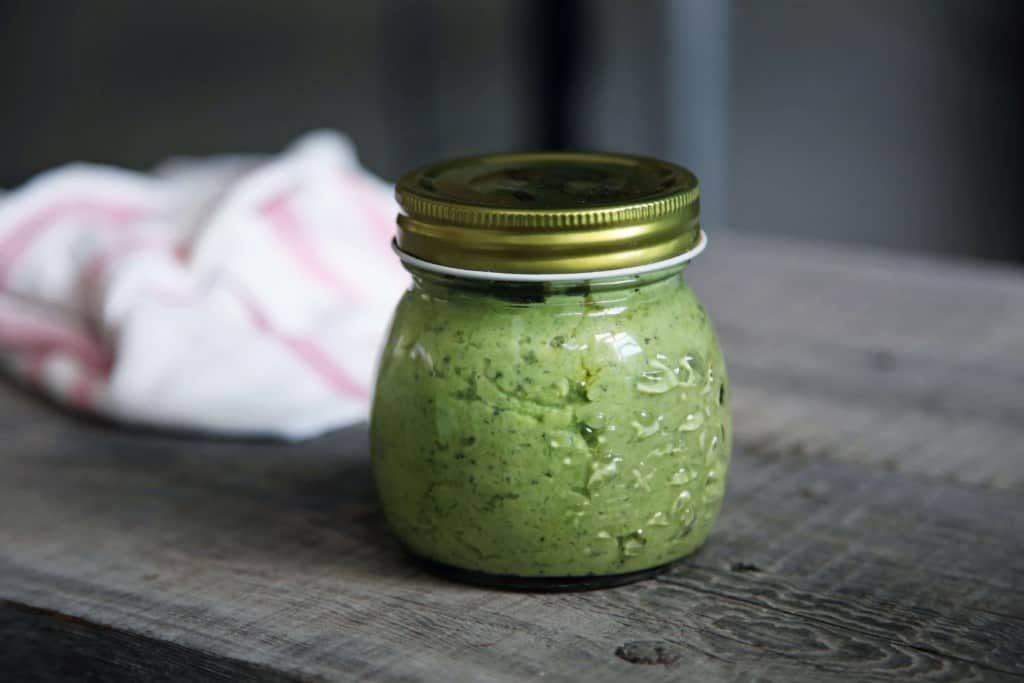
Pesto is one of the most popular sauces to combine with pasta, and the recipe for it is a bit simpler than you might think. There are many different ways to make a pesto sauce, and each one will create a unique flavor. What Does Pesto Taste Like?
Pesto tastes like garlic and either basil or parsley, but with a creamy texture. The creaminess comes from cheese, and a little bit of olive oil can add richness and an earthy flavor. In good pesto, no ingredient should be too dominant or too muted; you should be able to taste each element individually.
While most pesto recipes use the same few ingredients, the amount of the ingredients and the methods used can create different outcomes.
Let’s get a better understanding of the flavor of pesto by looking at the ingredients.
Table of Contents
What does Pesto Taste Like?

The primary ingredients in pesto are garlic, herbs, and some kind of nut.
The garlic should be added in small amounts, and should not overpower the other flavors of the pesto.
For the herbs, you can use either basil, parsley or both. For the nuts, traditionally it’s made using pine nuts, but it can be made using almonds, cashews, and walnuts. I’m sure you could make it with other nuts too, but I’ve never tried them.
Basil will give the pesto a more sweet and fresh taste. Parsley will make the pesto more mild, but pairing it with another strong herb will spice it up. Some different herbs you can use are:
- Cilantro
- Kale
- Mint
- Sage
- Tarragon
Another ingredient that can change the taste of pesto is cheese. Any kind of cheese can be used, but it must be aged, hard, and salty. Some examples of cheese you could use include:
- Parmesan
- Asiago
- Pecorino Romano
- Grana Padano
The final ingredient is nuts. For the nuts, it’s traditionally made using pine nuts but, since they can be expensive and hard to find, it can be made using other nuts such as:
- Almonds
- Cashews
- Walnuts
Making pesto is fairly simple, but here are a few suggestions on how to make it easier and tastier.
Why Does My Pesto Taste Like Grass?

While there are many right ways to use and create pesto, there are also some wrong ways. The worst outcome is having fresh pesto taste like a grassy bitter mess in your mouth.
The main reason pesto goes bitter is the extra virgin olive oil. The oil contains polyphenols (bitter-tasting molecules) coated with fatty acids. The acids keep the polyphenols from dispersing properly and naturally.
When all of the pesto ingredients are thrown in a food blender, the polyphenols are forcefully squeezed out. This is what causes the mix to turn bitter.
Your pesto might also have a grassy flavor because of the variety and quantity of the different herbs you’ve used. Using too many herbs can make the pesto taste like a mound of grass slathered in garlic.
No one likes a bitter or grassy pesto sauce, but there are multiple ways to fix this problem.
Ways to Fix Your Bitter or Grassy Pesto
There are some ingredients in pesto that can give off a bitter flavor. Taste-test everything before you use it in the pesto recipe. Also make sure you are using fresh ingredients, not expired or rotten. That is a health hazard as well as a taste hazard.
If you want to go authentic, blending the pesto by hand with mortar and pestle can help tone down the bitterness.
But if you would rather use tools from the modern era, blending all of the ingredients except for the olive oil will keep the pesto from getting bitter.
If all of the above fail, the last resort is salt. Salt counteracts bitterness in most foods, since tastebuds are prone to react to the salty flavor more than the bitter one.
When using salt, add small amounts progressively, tasting the pesto after each addition until it fits your preference. This can rightfully determine that the pesto is not too salty either, since salty pesto isn’t much better than bitter pesto.
To fix the grassy texture, make sure to not use too many different herbs at one time. You should use a maximum of 3 different herbs in your pesto. If you do use too many herbs, adding extra cheese, garlic, or other ingredients can help to balance it out.
What Can You Eat With Pesto?

The most common thing to eat with pesto is pasta, but there are many other things you can enjoy with pesto. Here are a few interesting alternatives you might like to try:
- Chips and Dip. Mixing a little pesto with some sour cream, greek yogurt, and even guacamole can add extra flavor to any party dip.
- Breakfast Add-Ins. Topping some eggs (any style) with pesto and a sprinkle of herbs and cheese is a great way to start your morning. Waffles and pancakes can also take a savory and healthier turn by mixing pesto into the batter instead of sugar.
- Pizza Night. Replacing the standard marinara sauce with pesto is a tasty alternative to this Italian favorite. Because pesto is a much richer sauce, it should be applied sparingly.
- Salad Dressing. Adding a little more olive oil or vinegar will create an intense pesto vinaigrette for your favorite salad.
- Marinade for Meat. Pesto is delicious with all different types of meat, including chicken, pork, fish, and steak. Pesto also pairs well with meatballs or meatloaf as an extra mixed-in ingredient.
- Soup Garnishing. Pesto served over potato soup, clam chowder, or a vegetable stew will add a touch of freshness and vigor.
These are just a few of the distinctive ways pesto can be used aside from pasta. There are many other tasty options that can be enjoyed for every meal.
5 Tips for Excellent Pesto

These tips and suggestions can be applied to any pesto recipe. There are many recipes for pesto, so don’t be afraid to try different combinations until you find your favorite.
- Wash the herbs: This is essential to avoiding a grainy or sandy texture in the pesto. Run them under cool water and pat them dry with a towel.
- Chop ingredients first: Start by chopping ingredients coarsely with a knife, this will help prevent the herbs from getting bruised in your food processor.
- Then use a food processor: this will help blend the ingredients together nicely and can make the texture smoother and creamier
- Grate cheese very fine: Grate the cheese on the fine-edged end of a grater, so that it mixes in well with the rest of the sauce
- Cover to avoid browning: When the pesto is done, cover it with plastic wrap for storage in order to prevent oxidation, which can turn your pesto brown.
Conclusion
At its best, pesto is a creamy, garlic-y, and fresh-tasting sauce. I personally love it and particularly enjoy it in pasta and on bread.
If you’re new to pesto, you can buy it pre-packaged in the grocery store. That’s a great way to dip your toe into the pesto-waters. Buy some at the store, and use it as the sauce for some noodles.
If you really want to give yourself the best shot of enjoying pesto, you might want to get it from an Italian restaurant instead. Why not leave the cooking to the experts for your first go? That’s all, I hope you enjoy it!
